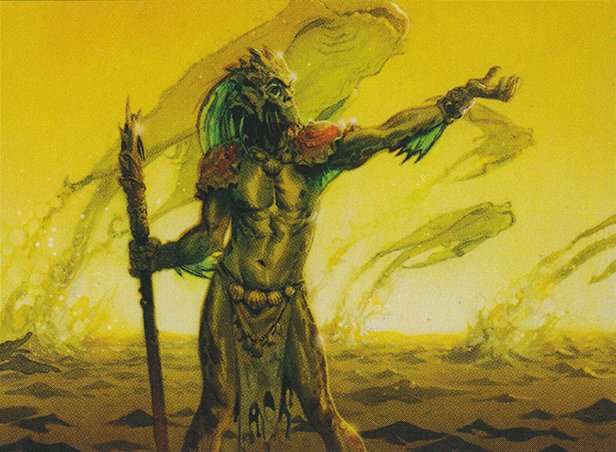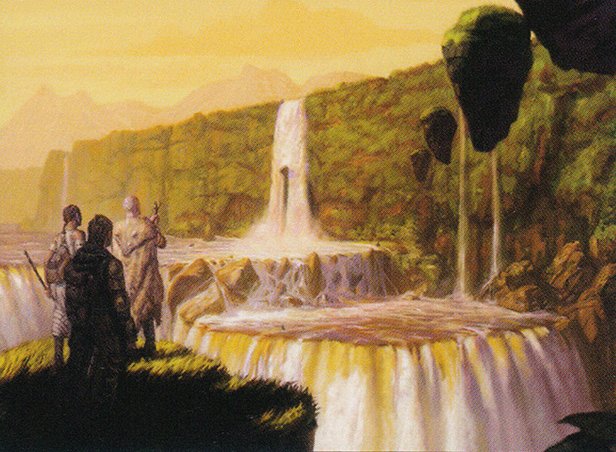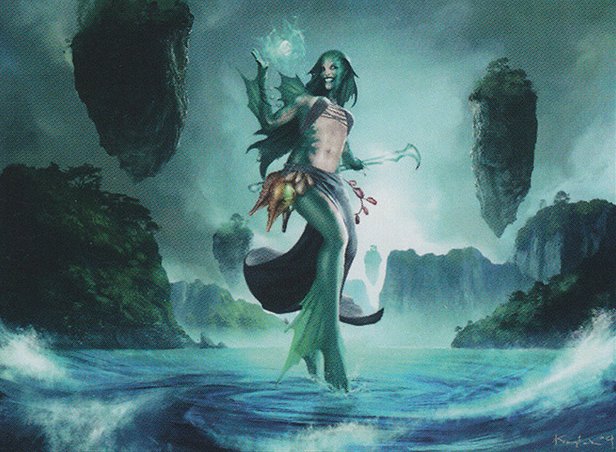A Planeswalker’s Guide to Zendikar: Tazeem and Merfolk
This content was deleted from the Magic website during an update. The original page can be accessed via Wayback Machine here.

Surrounded by unstable, scrub- and lichen-covered calcite flats, Tazeem is a perilous combination of reef-rock forests, a deep inland sea, and a great white-water river that bisects the continent. Some ancient ruins are prominently visible and have been co-opted by the denizens of Tazeem. Others remain hidden and intact, with mysterious artifacts and forces waiting to be discovered by intrepid explorers.
Emeria, the Sky Ruin

Colossal hedrons choke the sky above many parts of the continent. The rubble obscures direct sunlight and blocks natural rainfall patterns. As light filters through the stones, it moves in constantly shifting patterns across the ground, and objects often have multiple shadows from the diffuse light. The massive stones perpetually turn and tumble across the heavens; in constant motion yet bound by an invisible force that prevents the stones from moving beyond the edges of Tazeem.
Tazeem is the ancestral home of the merfolk, who believe that the rubble was once a glorious castle and home of the angelic Em, ruler of the wind realm. When the castle was destroyed in a cataclysmic upheaval, the enchantment that protected it wasn’t completely dispelled, and the shattered remnants remained in the heavens.

“Lullmages. Manipulative schemers and liars, all of them. Yes, they can tame the land. But they can use the same magic to tame a mind, too. And while you can see the Roil bow down to them, you won’t know they’ve got their fingers in your thoughts until it’s too late.”
Dyrde, kor cleric

Pathway Stones
The massive hedrons are covered in runes and retain magical properties even when they fall from the sky or are broken into shards. Pathway stones are the equivalent of lodestones; they always point to the direct center of the hedron field no matter where in the Tazeem they are located. Those who understand how to orient themselves according to the hedron field can use the pathway stones for navigation.
There’s a high demand for these pathway stones, which are usually sold in small palm-sized chunks. These are painstakingly chipped off the hedrons by cutter-traders, one of the must dangerous professions in Tazeem (because of the risk of falling, being crushed by colliding hedron pieces, or succumbing to other, more mysterious hazards). Cutter-traders are often merfolk who scour the surface of Tazeem for fallen stones, but they also use great daring and expertise to navigate Em’s Realm and retrieve pieces of the stones that are still in the air.

Halimar, the Inland Sea
Halimar isn’t a natural sea. Surrounded on three sides by rocky cliffs, the fourth side is enclosed by an ancient Sea Gate. The seawall is more than 500 feet tall with a white-stone cylindrical tower (now used as a lighthouse) that soars an additional 350 feet into the air. Collectively, the seawall and lighthouse are known as the Sea Gate, the largest settlement in Tazeem.
No one knows when the seawall was built, but they believe that Halimar must be an old sea because it is home to many species of brightly colored fish, tusked seals, and massive leviathans that dwell in the depths. Halimar is very deep—around 500 feet deep in some places. When Halimar is placid, the water is a sparkling cerulean. But when The Roil moves across the water, there are white-capped waves and treacherous whirlpools. Tidal waves crash against the sea gate and the cliffs. Despite the tumultuous seas and plethora of carnivorous sea creatures, it is viewed as the safest way to get from the Sea Gate to the mouth of the Umara River Gorge, and there is a substantial maritime trade and traffic on Halimar.

The Lighthouse at Sea Gate
The city of Sea Gate is the closest thing to a hub of civilization in Tazeem. The city is nominally based around trade houses, with a central house for blacksmiths, coopers, butchers, etc. The flat space at the top of the sea wall is approximately 20 acres, and nearly every inch has been built up with houses and shops. Even the narrow corridors between the buildings are covered because of the risk of attacks from drakes and other aerial predators.

“Gathering kindling in the Oran-Rief is one of the militia’s most important tasks. We must keep pyres all along the edge of the wall. They don’t help much with the dragon attacks, but they deter the drakes and keep the oozes and giant slugs out of the city.”
Rioden, captain of the Sea Gate Guard

At the eastern side of the sea gate stands the Lighthouse, a cylindrical tower that is the center of all learning in Tazeem. The Lighthouse has 20 floors and is a nexus for merfolk explorers/chroniclers. The walls are lined with leather scrolls filled with maps, spells, archeological finds, lists of plant and animal classifications, and theoretical discussions of The Roil.

Oran-Rief Forest
Much of the interior of Tazeem is an ever-expanding reef-rock forest. The formations of brittle rock are similar to a coral reef: branching plateaus, spiny towers, bristly fringes, and stratified layers with deep crevices and sun wells. This reef-rock forms in pale yellows, greens, and blues. The reef-rock is porous and pockmarked, and water drips through these crevices and holes. The rock itself is infused with magical properties and is continually expanding and growing, like a coral reef, although the rock itself isn’t alive. These reef-rocks can grow up to 100 feet tall and merge with surrounding reefs to form stratified plateaus that are hundreds of miles wide and tall.

Giant trees and other vegetation grows on this reef-rock—on top of the plateaus, surrounding the spiny formations, deep in the sun wells—wherever it can get even a small amount of light and water. The plants send out a mat of roots and engulf the rock so that in many places the rock isn’t visible through the undergrowth. The forest takes the shape of the rock below it, making bizarre shapes and silhouettes. Because of the scarcity of direct sunlight, the vegetation grows explosively fast whenever sunlight does manage to reach it. Known as Em’s Blessing, this explosive growth is both beautiful and dangerous. Animals and explorers can become caught and suffocated in the growth.

Pit Caves
There are numerous pit caves all over Tazeem. These are deep vertical shafts that lead down to the swampy underground caves. Birds make their homes in the walls of these caves, and some elves carve deep indentations into the walls to make sheltering places that are safe from The Roil. Some pit caves still have reservoirs of fresh water at the bottom and these are outfitted with a pulley system to bring the water to the surface. Other pit caves are filled with a choking mist that leaks into the air, poisoning anything that ventures too close to the mouth of the shaft. The most dangerous pit caves are those that look innocuous but are actually geysers that blast boiling water into the air.

“You want to go to Ruins of Ysterid, huh? The sages know they lie at the bottom of deep cave near Magosi Falls. But I don’t recommend it. The pit will poison you, boil you, and regurgitate your body up to the surface to be eaten by bloodbeaks.”
Piqua, Tazeem Expeditionary House

Umara River Gorge
From its source at Halimar Sea to the northern edge of continent, the Umara River runs through a deep gorge and drops over 800 feet over a series of waterfalls. The fast-flowing water is dangerous to navigate and is mostly white-water rapids throughout its length. Hundreds of tributaries branch out from Umara and wind through the Oran-Rief, and these smaller rivers tend to be less tumultuous than the Umara.
The gorge acts as kind of a wind tunnel, and merfolk make gliders that they can use to glide down the gorge. These gliders aren’t particularly practical, but some merfolk prefer them to the boats and portages. The Umara River Gorge is less affected by The Roil than anywhere else in Tazeem. Because of this, there are more settlements in the gorge and along portages than other places.

“I grew up in the cliff-caves of Wren Grotto, the most beautiful place in all of Zendikar. This the training ground of the giant falcons, and we paint the temples gold to honor them. In the wild, their nests are woven with gold from the strands of treasure only they know how to find.”
Ilori, merfolk falconer

Magosi Waterfall and Portage. Magosi is the largest waterfall along the river at almost 300 feet tall. No one has ever made it over the falls alive in a watercraft. The portage near the top of waterfall is a popular resting point for nomadic groups of various races; there are always traders and other explorers camped at the portage. In the inner continent, this is the best place to trade for pathway stones, supplies, and merfolk spell scrolls. Everyone travelling down the gorge must pass through the Magosi portage, but it is still a dangerous spot to spend the night. People routinely disappear in the night, and there are rumors of a massive, tentacled creature that lives behind the waterfall.


Curious, thoughtful, and analytical, the merfolk are natural explorers. Although the merfolk are born in the water, their appearance is more human than fish. They have muted skin colors, including ivory, beige, silver, and pale gold. They have residual fins on the backs of their arms and calves. The fins are sometimes streaked with brighter colors, such as green and blue. They have human-like hair in shades of silver, gold, and light browns. But like their fins, the merfolk’s hair often has streaks of bright color as well.

Although merfolk are a common sight in the settlements and trading posts of Zendikar, they are a race in decline. Merfolk tend to be more solitary than other races and don’t cultivate large communities. But even merfolk who spend most of their time exploring will establish a home base, a place they return to before setting out again.

Merfolk Enclave
Built on a large island in the middle of one of the widest sections of the Umara River, the Merfolk Enclave is a hive-like structure of rooms that look like bathing halls, corridors, and sleeping chambers. The Enclave is made from a rock that resembles pale sandstone that has glittering crystals embedded in it. Merfolk must be born in the water, so many merfolk return to the Enclave to find a mate or to give birth. While many merfolk consider the Enclave to be their home, most don’t live there full time.

Ula is a “pure” merfolk who dwells at the bottom of Halimar. He is the true ruler of water realm: the seas, the oceans, rivers and lakes. The same upheaval that destroyed Em’s castle also robbed Ula of his memory, but it left him with the knowledge of the task he must complete, the wrong he must avenge. He swims endlessly through the Halimar trying to rediscover what he was meant to do. Ula’s Guardians are two massive leviathans who protect Ula as he swims aimlessly through the dark water.
Chronicles of Ula

Merfolk Realms
The merfolk believe that the world is divided into three realms: Emeria, or the Wind Realm, which was once ruled by the angel Em and includes the sky, the wind, and the clouds; Ula’s Realm, the underwater realm; and Cosi’s Realm, which comprises everything else.
Zendikar is so dangerous and inhospitable that all other terrain is considered to be under the rule of Cosi, the Trickster. Cosi is believed to take the form of handsome humanlike being with a mischievous grin. He carries two kor-inspired hooked ropes that he uses to meddle in mortal affairs. Cosi has a chaotic nature. He will lure, scheme, and deceive for no reason but to incite chaos. Misfortune is usually blamed on Cosi’s meddling.

